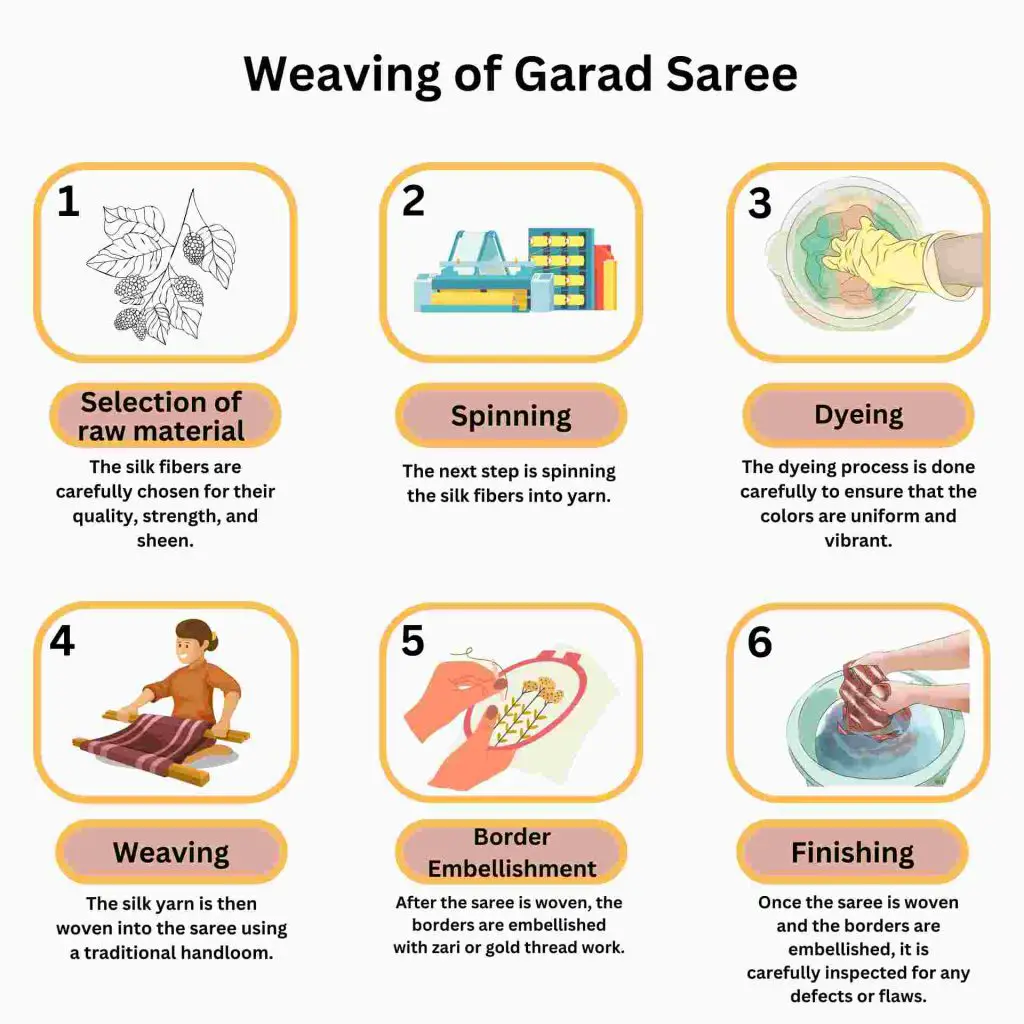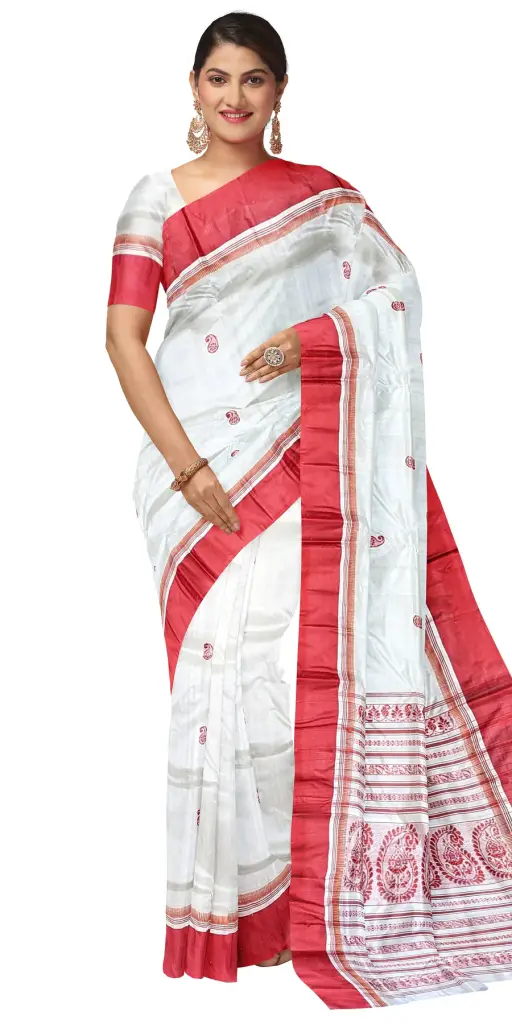When it comes to traditional Bengali sarees, the Garad saree is a true classic. Known for its pure white color and minimalistic design, the Garad saree has been a popular choice for Bengali women for generations.
It holds a special place in the heart of Bengali women.
Garad Saree is a type of Bengali saree that originated in the Murshidabad district of West Bengal. It is made from a special kind of silk fabric that is produced in the Malda district of West Bengal.
Garad silk is a natural fiber that is woven into a soft and lightweight fabric. The silk is known for its natural sheen and luster, which gives the saree a unique and elegant look.
In this article, we will explore the history, significance, and styles of the Garad saree.
GARAD SAREE ORIGIN AND HISTORY
The history of Garad saree can be traced back to the 15th century when the Mughal empire was ruling over India.
During this time, Bengal was one of the most prosperous regions of the country, and it had a rich tradition of silk weaving.
The Mughal rulers were particularly fond of Bengal silk, and they used it to create some of the most exquisite pieces of clothing.
The Garad saree is believed to have originated during this time when the Mughal rulers wanted to create a simple and elegant saree that could be worn by women of all classes.
Initially, Garad sarees were worn by women from aristocratic families during special occasions like weddings and religious ceremonies.
Over time, the saree became more accessible and was worn by women of all social classes on various occasions.
GEOGRAPHICAL PRESENCE OF TRADITIONAL GARAD SILK SAREE
Garad saree has its origins in the Murshidabad district of West Bengal in India. However, over time, it has become popular all over India and even internationally.
Garad saree is particularly popular in Bengal, where it is worn on religious and cultural occasions such as Durga Puja, Diwali, and weddings.
Apart from West Bengal, Garad saree is also popular in other parts of India such as Assam, Odisha, and Bihar, where it is known as Garad silk saree or Garad saree.
It is also exported to other countries such as the USA, UK, Canada, and Australia, where it is sought after by people who appreciate the beauty and craftsmanship of traditional Indian textiles.
In conclusion, Garad Saree is a timeless classic that has been worn by Bengali women for centuries.
It is a symbol of grace, elegance, and femininity making it a popular choice among women in West Bengal and beyond.
HOW IS GARAD SAREE MADE? [STEP BY STEP WEAVING PROCESS]
The production process of Garad saree involves several steps, each of which is critical to achieving the desired end product.

- Selection of Raw Material: The first step in the production of Garad saree is the selection of raw material, which is usually pure mulberry silk. The silk fibers are carefully chosen for their quality, strength, and sheen.
- Spinning: The next step is spinning the silk fibers into yarn. This is done using a spinning wheel or a machine, and the quality of the yarn depends on the skill of the spinner and the quality of the silk fibers.
- Dyeing: After the silk yarn is spun, it is dyed using natural dyes such as turmeric, henna, and indigo to give it a unique and vibrant look. The dyeing process is done carefully to ensure that the colors are uniform and vibrant.
- Weaving: The silk yarn is then woven into the saree using a traditional handloom. The weaving process involves interlacing the yarns in a specific pattern to create the desired design.
- Border Embellishment: After the saree is woven, the borders are embellished with zari or gold threadwork. This is done by skilled artisans using a needle and thread, and it adds a touch of grandeur to the saree.
- Finishing: Once the saree is woven and the borders are embellished, it is carefully inspected for any defects or flaws. Any imperfections are corrected, and the saree is washed and starched to give it a crisp and fresh look.
GARAD SAREE HERITAGE SIGNIFICANCE
The Garad saree has a long history entrenched profoundly in Bengali culture. It is regarded as a symbol of Bengali culture and has been a part of the region’s cultural fabric for generations.
It is not uncommon for a grandmother, mother, and daughter to wear the same Garad saree at various points in their life.
The Garad Saree represents Bengali culture and heritage. It is regarded as a holy garment worn at significant events. Bengali ladies usually wear it during religious rituals, weddings, and other happy events.
The white hue of the saree denotes purity, while the crimson border indicates riches and good luck. The saree is also connected with the ‘Shakta’ tradition of Hinduism, which stresses mother-worship.
The saree’s cultural significance has remained constant over time, and it remains an integral component of Bengali culture.
GARAD SAREE TYPES
Over the years, the Garad saree has undergone various changes and modifications to suit the changing fashion trends.
Today, there are several variations of Garad sarees that are available in the market. Some of the popular variations of Garad sarees are:
Silk Garad Saree
The Silk Garad Saree is made from pure silk and is known for its natural sheen and luster. The saree is often white or off-white in color and is decorated with simple and elegant borders.

Printed Garad Saree
This is a modern take on the Garad saree, where the saree is printed with various designs and patterns. The saree still retains its traditional red border, but the body of the saree can have floral, geometric, or abstract prints.

Tant Garad Saree
This is a variation of the Garad saree that is made of cotton instead of silk. The saree has a plain weave and a red border, just like the traditional Garad saree. The Tant Garad saree is lightweight and perfect for summer.

HOW TO DRAPE A GARAD SAREE FOR BEGINNERS? [STEP BY STEP]
Draping a saree is an art, and when it comes to draping a Garad saree in traditional Bengali style, it is a true reflection of the rich cultural heritage of Bengal.
![How to Drape a Garad Saree? [infographic]](https://colorsaree.com/wp-content/uploads/2023/04/Drape-Garad-Saree-infographic-1024x983.jpg)
Step 1: Choose the Right Garad Saree:
Before you start draping your Garad saree, it is essential to choose the right one. A Garad saree is traditionally white in color with a red or maroon border. However, you can also find Garad sarees in other colors such as cream, beige, or pink.
Step 2: Wear a Petticoat:
A petticoat is a long skirt that is worn under the saree. It provides a base for draping the saree and helps to hold it in place. Make sure your petticoat is comfortable and fits well. It should be tied tightly around your waist so that it doesn’t slip down while you are draping your saree.
Step 3: Start with Tucking the Saree:
Start draping the saree from the right side of your waist. Take the non-pallu end of the saree and tuck it into the petticoat at the right side of your waist. Make sure that the saree is not too high or too low from the ground.
Step 4: Make Pleats:
Take the remaining saree around your waist from the back to the front, and tuck it in the center of your waist, making pleats along the way. Ensure that the pleats are facing left and the remaining saree is on the right.
Step 5: Drape the Pallu:
Take the remaining saree (pallu) and drape it over your left shoulder in a way that the length of the pallu is at your back, and the border of the pallu is facing downwards. Make sure that the pallu is not too long or too short. It should be draped in a way that it covers your left shoulder and hangs loose at the back.
Step 6: Take the Pallu to the Front:
Bring the pallu from behind your left shoulder and drape it over your right shoulder, taking it from the front. The pallu should hang loose over your right shoulder.
Step 7: Tuck the Pallu:
Take the end of the pallu and tuck it in the center of your waist at the back, along with the rest of the saree. Ensure that the saree is neatly tucked in and not too tight or loose around your waist.
Step 8: Final Touches:
Adjust the pleats and the pallu to your liking. Make sure that the saree is not too tight or too loose.
GARAD SAREE MAINTENANCE TIPS
Garad saree is a delicate fabric, and it requires proper care and maintenance to keep it looking new and fresh.
It is recommended to handwash Garad saree in cold water using a mild detergent and to avoid using hot water, as it can damage the fabric. Do not soak the saree for too long, as it can cause the color to bleed.
Gently wash the saree and rinse it thoroughly. After washing, hang the saree to air dry in a shaded area.
Do not wring the saree, as it can damage the fabric. Instead, gently squeeze out the excess water and hang it to dry. Iron the Garad saree on a low heat setting.
Avoid using a high heat setting, as it can damage the fabric. Iron the saree on the reverse side, as it can prevent the embroidery or prints from getting damaged.
UNIQUE FEATURES OF GARAD SAREE
- Purity: Garad saree is made of pure mulberry silk, which gives it a soft and luxurious feel. The saree is usually not dyed, which gives it a natural off-white color and makes it suitable for religious ceremonies and other auspicious occasions.
- Minimalism: Garad saree is known for its minimalistic design, with a simple red border that is usually made of cotton. This simplicity adds to the elegance and timelessness of the saree.
- Handloom weaving: Garad saree is traditionally woven on a handloom, which gives it a unique texture and makes it more durable than machine-made sarees. The handloom weaving process also allows for intricate designs to be woven into the saree.
- Embellishments: Garad saree is often embellished with zari or gold thread work on the border, which adds a touch of grandeur to the saree without taking away from its simplicity.
GARAD SAREE PRICE
A basic Garad saree can cost anywhere from INR 2000 to INR 5000, while a more intricate and elaborate saree can cost upwards of INR 20,000.
The price range of Garad saree can vary depending on the quality of the silk, the intricacy of the design, and the expertise of the weaver.
However, regardless of the price, Garad saree is considered a valuable possession and is treasured by Bengali women for its cultural significance and timeless appeal.







